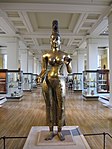British Museum Department of the Middle East

The Department of the Middle East (formerly Department of Western Asiatic Antiquities, then Department of Ancient Near East), numbering some 330,000 works, forms a significant part of the collections of the British Museum, and the world's largest collection of Mesopotamian antiquities outside Iraq. The collections represent the civilisations of the ancient Near East and its adjacent areas. These cover Mesopotamia, Persia, the Arabian Peninsula, Anatolia, the Caucasus, parts of Central Asia, Syria, the Holy Land and Phoenician settlements in the western Mediterranean from the prehistoric period and include objects from the beginning of Islam in the 7th century. A collection of immense importance, the holdings of Assyrian, Babylonian and Sumerian antiquities are among the most comprehensive in the world with entire suites of rooms panelled in alabaster bas-reliefs from Assyrian palaces at Nimrud, Nineveh and Khorsabad. Only the Middle East collections of the Louvre and the Pergamon Museum rival it in the range and quality of artefacts.
Excerpt from the Wikipedia article British Museum Department of the Middle East (License: CC BY-SA 3.0, Authors, Images).British Museum Department of the Middle East
Great Russell Street, London Bloomsbury (London Borough of Camden)
Geographical coordinates (GPS) Address Nearby Places Show on map
Geographical coordinates (GPS)
| Latitude | Longitude |
|---|---|
| N 51.51915 ° | E -0.12814 ° |
Address
British Museum
Great Russell Street
WC1B 3DG London, Bloomsbury (London Borough of Camden)
England, United Kingdom
Open on Google Maps










